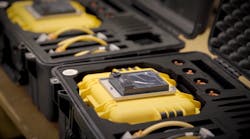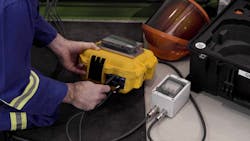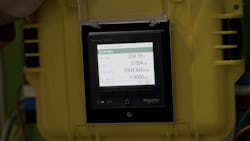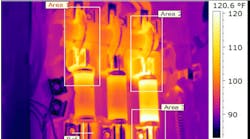Have you ever heard something along the lines of: “Motor #1 isn’t working, and it’s fed from Panel ABC. What do we do?” Or perhaps, “Breaker #2 in Substation XYZ keeps tripping. Does anyone know what is going on?” How do you find the answers to these questions?
The first place to look is to see if there is a permanently installed electrical meter nearby that is connected to a power monitoring system. If there is, you may have the necessary data to start determining the root cause of the problem. More commonly, we find either that there is no permanently installed metering and monitoring system — or the installed metering and monitoring system isn’t powerful enough to provide the data required to diagnose the root cause of the problem. Too often, permanently installed metering and monitoring systems are “value-engineered” out of projects as a cost-savings measure.
In these situations, you need a portable power quality metering system. Much like a cardiologist cannot diagnose a heart problem without using an EKG and viewing the heart’s signals, an electrical engineer can’t diagnose electrical problems without analyzing the sine waves that only a power quality metering system can provide.
What does it really mean to put a portable power quality system in place? There are several misconceptions in the industry regarding portable metering and the systems they connect to. Let’s take a closer look at some of them, and do some myth-busting.
Myth #1: I can only do energy studies.
Often, portable metering is used for energy studies when there is no permanently installed metering. There are many “energy-only” portable meters available in the market. They will record energy consumption in kilowatt-hours (energy consumed over time) or peak demand (maximum consumption during a specific time). However, these meters give no visibility on power quality issues.
Energy studies are an important part of operating cost reduction programs, but power quality studies can be even more valuable. Power quality issues in an electrical distribution system can damage equipment such as motors, variable-speed drives, capacitor banks, and lighting; this can result in damage to infrastructure or personal injury, resulting in downtime that costs far more than any potential energy savings. As described earlier, the path to understanding what is happening with a power distribution system is to view the sine waves. Energy-only meters (like an electrician’s standard multimeter) do not provide the proper data to see the sine wave.
According to Pacific Gas and Electric, “Approximately 80% of power quality problems originate from the customer's operation.” That means that most power quality issues you face are created by your facility, not by your electric utility.
The advanced algorithms in portable meters allow you to perform power quality and energy studies as well as many others. The insight a power quality meter provides over an energy-only meter paired with a visualization and analysis software solution is the key to understanding the performance of the electrical distribution system.
Myth #2: I can figure it out on my own.
Interpreting data from an advanced portable meter requires expertise. That expertise is found in firms that have personnel with power quality and energy management experience. For example, a key component of power quality analysis is to examine the voltage and current waveforms captured during a power quality incident. Examination of the waveform deviations can indicate the potential cause of the power quality incident.
Much like a fingerprint can help in identifying a culprit in a crime story, a sine wave can provide telltale signs of the origin of the problem. A police department would use a professional criminologist to interpret evidence — power quality engineers are the criminologists of the sine wave.
If you need help, find a team of experts with subject matter expertise in power quality who are ready to assist you in providing a detailed study of power quality and other electrical issues at any site around the world.
Myth #3: I must wait for the report.
Traditional portable meters record data on internal memory, either embedded or removable with an SD card. During the observation period, the meter records measurements in that memory. An expert then comes on site to download the measurements into a software application and create a report. There are three problems with this legacy architecture:
- You must wait until after the observation period to get results.
- Any configuration errors in the meter will not be detected until the expert is back on site, leading to more wasted time.
- You are limited by the meter’s memory capacity to collect data points, potentially requiring multiple observation periods.
Thanks to cloud connectivity, you can now view data from a portable meter within minutes of configuring it. These “online” portable meters connect securely to a cloud-based platform where you can immediately view live data, trends, and reports. You get a view of what is happening in your facility without waiting for an expert to download and process the data into a report.
Additional benefits of an online portable meter are:
- The meter will continuously send data to the cloud (if needed) with no memory limitations. This means you can send much more data — higher sampling rates and more data points, including power quality, status, and compliance data.
- Data from multiple portable meters can be combined and displayed, trended, and analyzed in the same environment in real-time.
- You can immediately detect any misconfigurations or installation issues with the meters — no more waiting until the data is downloaded to realize you must start all over again. Common installation mistakes can be identified and corrected before the technician leaves the facility.
- If a portable meter is detached or tampered with during the observation period, it can be identified right away. With a typical portable meter, there would be no way to verify proper operation during the observation period.
Myth #4: It’s about the portable meter.
Because the industry started with portable meters, simple PC-based software, and static reports, it is tempting to focus on the meter itself as the valuable part of a portable metering solution. But much of the value of a portable metering solution is beyond the meter. The software platform that the meter connects to — as well as the advisory services that interpret the data — are critically valuable parts of the system.
The power of a cloud platform to process data from a portable meter cannot be overstated. Thanks to Internet of Things (IoT) connectivity, portable meters can now leverage the same algorithms and analytics that were previously reserved for permanently installed metering via an energy management platform. As an example, with a portable meter connected to an IoT Energy and power management platform, a chronic power quality issue can be decisively linked with load loss and with the location of the disturbance. The platform can also detect load recovery, even in the presence of daily load fluctuations, which allows for a mitigation solution to be designed with a concrete ROI.
The power of the IoT and cloud to unlock new levels of insights and analysis is well understood in many areas — from health care to transportation. The same type of transformational applications and value are now available in portable metering systems.
Myth #5: Service providers need three visits before customers get results.
Portable metering service providers are used to a standard procedure when deploying a portable metering study.
- Go on site to install and configure the meter(s).
- Start the observation period.
- Return after the observation period to download the meter data, and remove the portable meter.
- Prepare the report with the download data.
- Book a meeting with the customer to review the results from the report.
This creates three separate scheduling events for customers, two of which provide no direct value. With a cloud-connected portable meter, the new procedure looks like this:
- Go on site to install and configure the meter(s), and connect it to the cloud-based metering platform. Show the customer how to log in, and start seeing live data/reports that generate insights immediately.
- Back at your office, monitor the data coming in, and watch for any signs that the meter has been misconfigured or tampered with while it was installed. Prepare your report from the cloud platform before you return to the customer site.
- Return to the customer site to deliver your reports, and pick up the meter at the same time.
With this approach, you dramatically increase the value of customer meetings, and you save yourself a low-value trip to collect the onboard meter data.
Let’s take a look at some real-world scenarios to put these best practices into perspective.
Customer challenge #1
Imagine 60,000 fans walking through stadium entrances and corridors to cheer on their team from the stands when suddenly the lights flicker on and off. The field goes dark, play is interrupted, and the stands go silent. This scenario was repeated regularly at a large stadium, causing embarrassment and concern to the stadium and team owners, not to mention disappointment to fans. After repeated unsuccessful attempts by electrical contractors to solve the problem, the lighting manufacturer contacted a power quality consultant for assistance.
The power quality consultant deployed a portable power quality meter that sent data to a cloud-based energy and power management platform. With data from the portable meter, power quality experts detected resonance at the 15th harmonic, which was causing the lights to fail. Due to their expertise with power quality issues, the experts identified that the resonance was a result of incomplete commissioning of harmonic filters two years earlier. After the harmonic filters were reconfigured, the lights never flickered again.
Customer challenge #2
A bank’s modern headquarters has several large loads, including four chillers and approximately 200 variable-speed drives (VSDs) for chillers and pumps, 150 air conditioners, and other loads. The varied loads have contributed to severely distorting the AC voltage through rectification. The resulting power quality issues (mainly harmonics) put a strain on the site infrastructure, specifically the cogeneration units, which lead to outages.
The first step taken was to deploy 10 portable metering units to understand the nature of the power quality issues across the entire facility. During the tendering process, power quality experts were actively analyzing the data from the meters and discussing all of this with the consultant. Based on the power quality audit results from the portable metering, the power quality consultant proposed a complete solution built around 21 active harmonic filtration units, connected to software and accompanied by 16 power quality meters at strategic locations in the building.
After the solution was deployed, harmonics were returned to acceptable levels. The bank was able to reactivate its cogeneration equipment. There have been no further failures at the site that have resulted in lost productivity and downtime. The facility team now has confidence in the electrical system.
Wrapping it up
Properly selected portable metering systems equipment paired with proper engineering skills will provide the data necessary for the identification of power system problems. The data acquired is also fundamental for the development of corrective actions to remediate power system problems. Portable metering should provide a total solution, which entails both the metering hardware combined with a software solution for visualization and analysis, paired with skilled engineers to evaluate the data.
Jason Heindel is a director of solutions and strategy for AZZO USA. He can be reached at [email protected].





